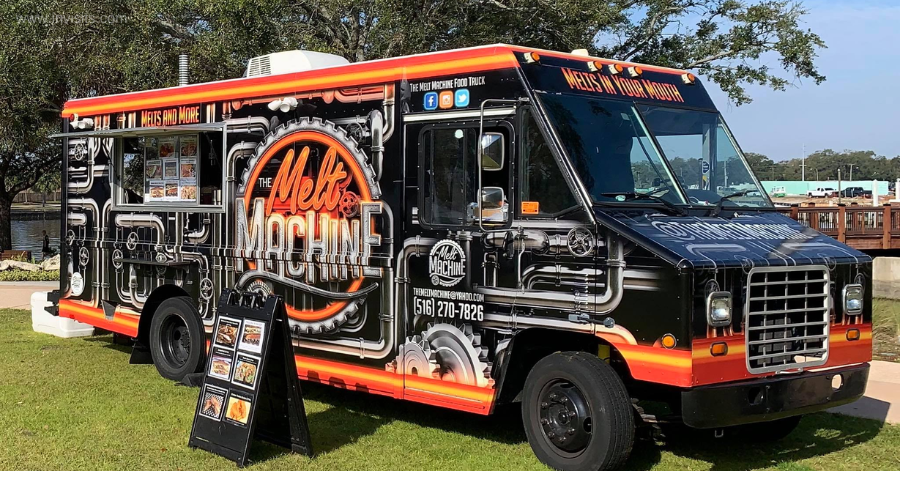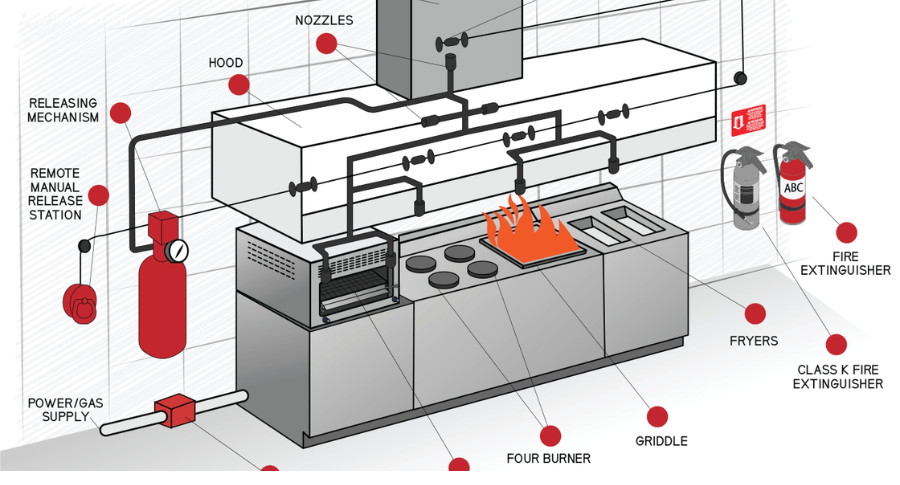The sizzle of the Grill, the aroma of fresh spices, the happy faces of satisfied customers – these are the hallmarks of every successful food truck. But lurking behind the deliciousness is a constant threat: the danger of fire. In a confined space packed with cooking equipment and flammable materials, a small kitchen fire can escalate quickly, turning your dream business into ashes. That’s why investing in a food truck fire suppression system is not just wise – it’s essential.
Why Are Food Trucks at Higher Risk?
Compared to traditional restaurants, food trucks face unique fire hazards:
- Limited space: With cramped quarters, a fire can spread rapidly, leaving little room for escape or firefighting efforts.
- Concentrated equipment: Grills, fryers, and other cooking appliances generate intense heat and are often positioned close together, increasing the risk of accidental ignition.
- Flammable materials: Cooking oils, grease, paper products, and even the food itself can fuel a fire if not properly stored and disposed of.
- Mobility: The constant movement of the truck can loosen connections and damage equipment, potentially creating fire risks.

The Vital Role of Fire Suppression Systems
A food truck fire suppression system acts as your first line of defense against these dangers. It detects a fire at its earliest stage, automatically releasing extinguishing agents to suppress the flames before they have a chance to take hold. This critical action can:
- Buy precious time: The system gives you and your staff valuable seconds to evacuate and call emergency services.
- Minimize damage: Early fire suppression can prevent extensive damage to your equipment and inventory, saving you money and downtime.
- Boost safety: Knowing you have an automatic fire safety net in place provides peace of mind and allows you to focus on serving your customers.
Types of Food Truck Fire Suppression Systems
Several types of fire suppression systems are suitable for food trucks, each with its own advantages and drawbacks:
- Wet chemical systems: These use a water-based solution to smother the fire, effectively extinguishing flames and preventing reignition. However, they can cause water damage and may not be suitable for all types of cooking equipment.
- Dry chemical systems: These release a powder that coats the fire and interrupts the combustion process. They are less messy than wet chemical systems but may leave residue on surfaces and can irritate eyes and lungs.
- Carbon dioxide systems: These rapidly flood the enclosed space with CO2, displacing oxygen and suffocating the fire. They are clean and leave no residue but require careful ventilation after discharge.
- Kitchen hoods with integrated suppression systems: These combine a traditional ventilation hood with built-in nozzles for targeted extinguisher agent delivery. They offer space-saving convenience but may not be effective for fires outside the hood area.

The Right System for Your Food Truck
The best food truck fire suppression system for you will depend on several factors, including:
- The size and layout of your truck: A larger truck will require a more powerful system than a smaller one.
- The type of cooking equipment you use: Different extinguishing agents are suited for different types of fires.
- Your budget: Systems range in price, so it’s important to find one that fits your financial constraints.
- Local regulations: Check with your local fire department to ensure the system you choose meets all safety codes.
Beyond the System: Essential Fire Safety Practices
While a fire suppression system is Crucial, it’s just one part of a comprehensive fire safety plan. Here are some additional steps you can take to protect your food truck:
- Regular maintenance: Inspect and clean your cooking equipment regularly to remove grease buildup and potential fire Hazards.
- Fire extinguisher training: Train your staff on how to use a fire extinguisher safely and effectively.
- Regular fire escapes: Keep all escape routes clear and unobstructed at all times.
- Fire safety awareness: Educate your staff on fire prevention practices and common kitchen Hazards.
Investing in Peace of Mind
A food truck fire suppression system is an investment in your business, your employees, and your customers’ safety. It provides peace of mind knowing you’ve taken all necessary steps to protect your passion from the devastating effects of fire. By choosing the right system, implementing proper safety practices, and remaining vigilant, you can ensure your food truck continues to bring joy and deliciousness to the streets, one satisfied customer at a time.
Additional Resources
- National Fire Protection Association (NFPA): https://www.nfpa.org/
- National Restaurant Association (NRA): https://restaurant.org/

Delving Deeper into Food Truck Fire Suppression Systems: A Technical Toolbox
In our previous discussion, we painted a broad picture of the importance of food truck fire suppression systems. Now, let’s dive deeper into the technical specifics, equipping you with the knowledge to make informed decisions about protecting your culinary haven.
System Components and Operation:
A typical food truck fire suppression system will comprise several key components:
- Detection unit: Heat detectors, smoke detectors, or flame detectors sense the presence of fire early on.
- Control panel: This central hub houses the system’s electronics, displaying the system’s status and allowing manual activation if needed.
- Discharge cylinder: This pressurized container holds the extinguishing agent, waiting to be released upon activation.
- Piping and nozzles: A network of pipes distributes the extinguishing agent to strategically placed nozzles throughout the cooking area.
- Manual pull station: An easily accessible manual trigger for immediate system activation in case of emergency.
Once a fire is detected, the control panel triggers the release of the extinguishing agent. Depending on the system type, this may occur automatically or require manual confirmation. The agent then floods the protected area, rapidly suppressing the flames and preventing further spread.
Choosing the Right Agent:
Each type of extinguishing agent has its strengths and weaknesses, making it crucial to choose the one best suited for your food truck:
- Wet chemical: Effective against a range of fires, including cooking oils and fats, but can cause water damage and may interfere with electrical equipment.
- Dry chemical: Clean and quick-acting, but can leave residue and pose respiratory hazards. Choose a food-safe variety to avoid contaminating food preparation areas.
- Carbon dioxide: Highly effective and leaves no residue, but displaces oxygen and requires proper ventilation after discharge. May not be suitable for enclosed spaces with poor ventilation.

Installation and Maintenance:
Professional installation by a qualified technician is essential to ensure the system’s proper functioning. Regular maintenance, including inspections, leak checks, and agent refills, is vital to keep your system at peak performance. Consult your system’s user manual and local fire codes for specific maintenance requirements.
Going Beyond the Basics:
For an extra layer of protection, consider these additional features:
- Early warning systems: Gas leak detectors for propane appliances can provide an additional level of fire prevention.
- Automatic shut-off valves: These stop the flow of gas to cooking equipment in case of fire, preventing fuel from feeding the flames.
- Fire blankets: Easy-to-use fire blankets can smother small fires before they escalate.
Remember:
- Local regulations: Always comply with local fire codes when choosing and installing a fire suppression system.
- Training: Train your staff on the operation and maintenance of the system, including safe extinguisher use.
- Regular testing: Conduct regular tests and drills to ensure everyone is prepared in case of a fire emergency.
Related article: Childrens Party Food Boxes Filled with Tasty Treats & Joy!
A Final Dose of Culinary Confidence:
By making informed decisions about your food truck fire suppression system, adopting sound safety practices, and staying vigilant, you can create a fire-safe environment where your culinary creativity can flourish without fear. As the aroma of your signature dish fills the air, embrace the knowledge that you’ve taken proactive steps to safeguard your passion and keep your dream truck rolling, fire-free, and filled with happy customers.
Bonus Tip: Explore online resources and connect with other food truck owners to share experiences and gather insights for optimizing your fire safety measures. Remember, knowledge is power, and when it comes to fire safety, a little extra power can go a long way in protecting your beloved food truck.
FAQs
It’s crucial for safety, swiftly extinguishing fires in confined spaces, preventing damage, and ensuring compliance with regulations.
Utilizing advanced technology, it detects and suppresses fires automatically, employing a combination of agents to swiftly control and extinguish flames.
Not at all. Our systems are designed for easy installation, and our team provides comprehensive guidance and support throughout the process.
Regular inspections are recommended every six months to ensure optimal functionality. Our team can schedule and conduct these inspections efficiently.
Absolutely. We offer tailored solutions to fit various food truck configurations, ensuring effective fire suppression regardless of the size or layout.


0 Comment